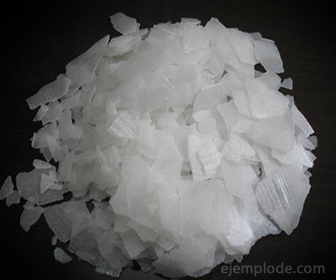Example of Chemical Compounds
Chemistry / / July 04, 2021
The Chemical compounds they are pure substances whose structural units are molecules. A chemical compound is result of the combination of two or more chemical elements.
Chemical Compounds, rather than Elements, are present in everything that exists In the universe. In fact, it is more difficult to find free Chemical Elements than Compounds.
From minerals, made up of compounds such as binary salts and oxisalts, to living organisms, made up of Proteins, Carbohydrates, Lipids, Chemical Compounds have a wide presence.
Characteristics and properties of Chemical Compounds
Physical state
Chemical compounds manifest themselves in nature in a physical form, whether solid, liquid or gaseous, which will always allow them to be identified.

Density
Chemical Compounds are Matter. And being matter, they will cover a volume. One understanding is that, if the Compound molecules are small, they will naturally meet more compact with each other, promoting that there is more mass in a volume, what is a Higher density.
Melting and Boiling Points
All existing compounds have their three physical manifestations: Solid, Liquid and Gaseous. At room temperature, it is remarkable what physical state they are in.
The Melting point It is the Temperature at which a Solid melts or melts, becoming a liquid. It is also called Freezing Point, because it indicates the change between liquid and solid. It can be said that at the lowest temperature, Absolute zero (0 Kelvin), all compounds would be theoretically Solid.
The Boiling point It is the temperature at which a liquid begins to boil to transform into a gas. It can be said that at the highest temperature, all compounds would theoretically be Gaseous.
Stability
Chemical Compounds are formed precisely so that the atoms of the Elements find their chemical stability, through bonds that complement their valence electrons.
Reactivity
Chemical compounds are capable of interacting with other compounds, or with pure Elements, in such a way that they are transformed during a chemical reaction to form new substances. Some are more Reactive than others.
The factors that modify Reactivity are the Temperature, the Pressure, the Physical State and the Quantity of the substance with which the compound participates in the chemical reaction.
Each type of chemical compound is distinguished by a particular way of acting. Such as those that behave as Acids and Bases, which are governed by the Acid-Base Theories.

Solubility
Especially if it is those formed by Ionic bonds, Chemical Compounds can get involved with Water to form Aqueous Solutions, with the compound ions dispersed in the medium, capable of conducting an electric current.
Classification and types of Chemical Compounds
The wide variety of chemical compounds can be organized according to two simple criteria:
- By the Links that Form them: Ionic Compounds and Covalent Compounds
- By its Chemical Nature: Inorganic Compounds and Organic Compounds
Ionic Compounds and Covalent Compounds
The Chemical Elements that make up the Compounds are capable of generating bonds, but it will depend on the same Elements what type of Bond it is.
In the Ionic Bond, the atoms will be united by the electrostatic charges that their valence electrons generate. They are capable of dissociating in Water, generating aqueous solutions that can conduct an electric current.
In the Covalent bond, the atoms will retain each other thanks to the fact that one of them will share its valence electrons so that another receives them. These bonds are generally strong and are not so easily disturbed by water.
Inorganic Compounds and Organic Compounds
Inorganic Compounds are identified by being part of mineral materials. They represent precisely the Inorganic chemistry. Among them are the You go out, the Oxisales, the Hydracids, the Oxyacids, the Hydrates, the Oxides, the Hydroxides, the Peroxides.
Organic Compounds are identified by being part of living matter and Compounds whose structural base is the Carbon Element. They therefore represent the Organic chemistry. Among them are Hydrocarbons (Alkanes, Alkenes, Alkynes), the Alkyl Halides, the Alcohols, the Aldehydes, the Ketones, the Carboxylic acids, the Anhydrides, the Esters, the Ethers, the Amines, the Amides, the Aromatic Compounds, the Phenols, the Organometallic, the Amino acids, the Protein, the Carbohydrates, the Polymers, the Heterocyclic Compounds, the Terpenes, and many other Compounds resulting from the combination of the above.
Examples of Inorganic Chemical Compounds
Sodium Chloride NaCl
Calcium Chloride CaCl2
Ferrous Sulfide FeS
Potassium K Sulfide2S
Ammonium Hydroxide NH4Oh
Ammonium Sulfate (NH4)2SW4
Calcium Phosphate Ca3(PO4)2
Silver Nitrate AgNO3
Potassium Nitrate KNO3
Hydrochloric Acid HCl
Hydrogen Sulfide H2S
Nitric Acid HNO3
Sulfuric Acid H2SW4
Magnesium Sulfate Heptahydrate MgSO4* 7H2OR
Magnesium Sulfate Pentahydrate MgSO4* 5H2OR
Ferric Oxide Fe2OR3
Magnetite Faith3OR4
Sodium Oxide Na2OR
Hydrogen Peroxide H2OR2
Barium Peroxide BaO2
Examples of Organic Chemical Compounds
Methane CH4
Ethane C2H6
Propane C3H8
Methyl Alcohol CH3Oh
Ethyl Alcohol C2H5Oh
Methyl Chloride CH3Cl
Ethyl Chloride C2H5Cl
Formic Acid HCOOH
Acetic Acid CH3COOH
Sodium Benzoate C6H5Na
Terbutyl Lithium C (CH3)3Li
Ethyl Magnesium Bromide C2H5MgBr
Ethyl Ether C2H5OC2H5
Glucose C6H12OR6
Sucrose C12H22OR11
Methylamine CH3NH2
Ethyl Amine C2H5NH2
Acetone CH3Car3
Methyl Mercaptan CH3SH
Ethyl Mercaptan C2H5SH

